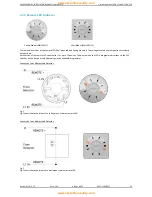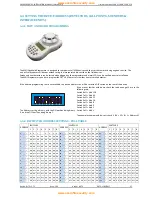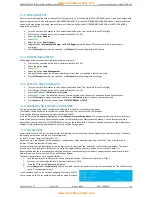
PREMIER QUATRO INSTALLATION MANUAL (Fyreye MKII) Firmware Versions: PANEL 1.84 & LOOP 3.70
Doc No: GLT-215-7-1 Issue: 1.36 Author: NJ/TE DATE: 25/05/2017
17
4.7 SYSTEM SPARE CAPACITY
The UK Fire alarm system code of Practice for Designing, Installing, Commissioning & maintaining fire alarm systems, BS5839
recommends allowing at least 25% free capacity when designing a fire system.
This is a good precaution as it allows for:-
Changes to the system requirements before the site is finished
Additional devices identified as part of the commissioning process
Future Changes to the building layout (e.g. partitioning an open plan area)
If a system is designed to full capacity, any small additions might mean substantial changes (Extra loops or even having to network
an extra panel)
4.8 PRE COMMISSIONING CHECK LIST
The following information is designed to help minimise issues encountered when commissioning a system.
1.
PANEL
.
First fit the panel and connect the mains power supply and batteries. Now with
NO
external circuits or loops
connected, turn the panel on and check that the panel runs with no faults.
2.
LOOPS.
Starting with one loop at a time, check b & + for continuity and note the resistance (which should be
no more than 22Ω maximum (Less than 15Ω recommended)). Carry out the same test between - & -. Note this should be
done before any devices are connected. If the isolators have been connected then you will get an open circuit reading.
Also make sure that the screen (earth) has continuity and is not showing an open circuit.
Now test between the + & -
core making sure there is no short circuit, repeat this test b & screen and - & screen.
3.
ADDRESS DEVICES.
When you have checked the loop cables, you can now number all the devices and connect loop
1 to the panel. Turn the panel on and autosearch loop 1. Once the panel has finished the autosearch process check that
the total devices found match the devices fitted to the loop. If at this stage the panel reports faults (loop open circuit,
loop short circuit, earth fault or double addresses), rectify the faults before moving on to the next loop. Repeat this
process for each loop (
REMEMBER TO FIT ONE LOOP AT A TIME)
.
4.
CONFIGURE THE PANEL.
Once you have all loops running without any problems, connect the laptop and take a
download of the system. Program all the device text, zone text and zone numbers, also any cause and effects
requirements. Upload this information in to the panel and test all devices making sure the correct information is shown
for each device.
If you have more than one panel, repeat steps one to four.
5.
NETWORKED SYSTEMS.
If the system is on a network, leave networking the panels until after you have each
panel working. Now add one panel at a time and check the network functions between the first two panels. Once you
know that the first two panels are communicating ok, then add the third panel and check the network operation
between the three panels. Repeat this procedure for each additional panel.
www.acornfiresecurity.com
www.acornfiresecurity.com
















































